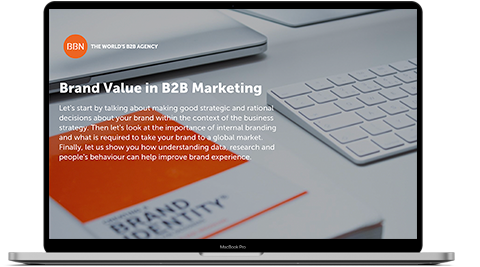Posted by BBN Central on 12th Apr 2024
The Brave New World of B2B Influencers
Welcome to the third instalment, focusing on smart investment strategies for fearless marketers aiming to win market share in the
READ MOREPosted by Leo Boon Yeow - BBN Singapore on 14th Nov 2016
Account-based marketing (ABM) is a marketing technique that’s about identifying, and targeting with personalised messages the accounts that matter the most to your organisation’s goals. It’s designed to focus on, attract (clients and prospects) engage, convert, and measure the progress of your campaigns.
According to DemandBase, one of the world’s premier marketing agencies, 71% of B2B organisations are interested in ABM, are testing it, or already using it. 96% of B2B marketers who’ve used ABM report a positive impact on their marketing’s success.
This points to ABM becoming the default marketing technique that companies use first before anything else. Thanks to its incredibly attractive ROI, marketers are attempting to use ABM on all the accounts their companies care about, regardless of size or vertical.
This is because based on the Pareto principle (the 80-20 rule which is the core of ABM), nearly 80% of sales comes from 20% of your customer base—customers you’re targeting with ABM. These customers require (and sometimes even demand) your understanding of their business, and provide them with tailored solutions.
Instead of targeting a wide range of customers hovering at the top of the funnel, you target these companies that have the potential to yield the best results. This ensures your effort-to-yield ratio is as attractive as your ROI.
However, for ABM to do its work, your organisation should be aligned internally. Your sales teams and your marketing teams should work as one. This means the messaging from them has to be organised and carefully choreographed to be identical from the first to the last touch.
While ABM’s concept is straightforward—identify important accounts, and sell personalised messages accordingly—pulling it off requires some effort on your part. Follow these five steps to ensure a successful campaign.
This is the first and perhaps the most important step as it sets the pace for the rest of the campaign. Build a target list, comprising companies with the most potential to your business. The people in this list can include customers, prospects, partners, or a mix of all three of these categories.
Next, conduct further analysis to identify your accounts by industry, revenue (or size), current use of what you’re selling, and whether or not they’re even worth spending time on more for deeper analysis.
Once you’re done here, you go on to analyse the stakeholders that are important to your campaign. Acquire data about these people through your existing sales and marketing database, through top-of-the-funnel (TOFU) campaigns or databases from third-party agencies (like the GetIT Intellibase).
After your data has been processed, come up with a lead score. This involves ranking your potential prospects according to the business perceived value each lead has. The resulting score will determine the receiving function your lead will get in order of priority. High ranking prospects should receive direct contact from the sales team, while low ranking prospects will get a phone call from your tele-prospecting team.
Following that, strategise on how you want to reach your prospects, by coming up with a workflow (communication blueprint, touchpoint map, and so on). This workflow will help you understand more about the campaign, discover gaps and figure out the key CTAs and destinations for the whole plan or subset (e.g. by audience or communication objectives).
This is the meat of the ABM campaign. Your content. Develop account specific messaging, based on the needs, competitive advantage, positioning strategy and the USPs of your clients. In other words, personalised content.
At this point, conducting a content audit will minimize the amount of work necessary. Stock-checking and identifying usable existing content for specific accounts saves you both time, and money. This step is easily done by mapping content with target personas, channels (selected during workflow planning and procurement process stages).
Once you’ve identified reusable content, you’ll be able to find the gaps that require content to fill—content that’s either fresh, repurposed or curated from other sources.
Once the content is ready, you can deploy it according to your strategic workflow. It can be on an account specific microsite, or a site segment development. Follow up with account specific email campaigns to known contacts, and perhaps a LinkedIn InMail campaign for unknown contacts.
For unidentified leads and prospects, rely on targeted display advertisements (Google Display Network, Twitter, Facebook) to reach them. To get better mileage out of your campaigns, you can conduct account specific nurturing, through digital content nurturing, or account specific workshops or breakfast briefings.
To tie the whole campaign together you can use highly specialised tools in project management (Basecamp), analytics (Google Analytics), reporting (Tableau) and optimisation (SharpSpring). With judicious use of these tools, coupled with a strict adhesion to your plan, you’ll be able to target your potential leads and prospects with pinpoint accuracy, leading to higher conversion rates, and better ROI.
With all these processes and tools at your disposal, there’s really no better time than now to start experimenting with ABM, so you can see for yourself the incredible improvement that this technique will bring to your marketing campaigns. However, bear in mind that the onus is still on you to create innovative, personalised marketing programs in order to achieve maximum efficacy.
Posted by Leo Boon Yeow - BBN Singapore on 14th Nov 2016
We've gathered thoughts and expertise from our top strategists to bring you this insightful publication in B2B marketing. Get our e-Book to understand how you can build brand value in your organisation.

1 email a month, EXCLUSIVE stories, and 10 minutes of your time.
Subscribe now
Posted by BBN Central on 12th Apr 2024
Welcome to the third instalment, focusing on smart investment strategies for fearless marketers aiming to win market share in the
READ MORE
Posted by BBN Central on 5th Apr 2024
In B2B marketing, the compass that points businesses towards success is increasingly data-driven. Here at BBN, we've been keenly observing
READ MORE
Posted by BBN Central on 29th Mar 2024
Since the introduction of Sora, OpenAI's text-to-video model, the worlds of AI and marketing have been abuzz. It's being called
READ MORE
Posted by BBN Central on 19th Mar 2024
Account-Based Marketing (ABM) has rapidly gained traction in the B2B marketing world, promising personalized and efficient strategies to win over
READ MORE